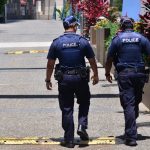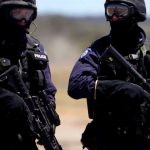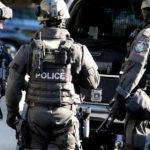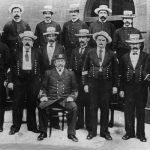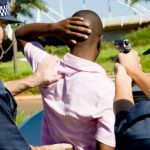Semi-Automatic Weapons: Another Step in the Militarisation of NSW Police
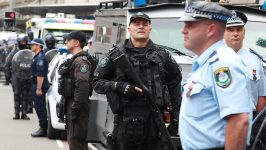
As of last Monday, Sydneysiders will have to get used to seeing NSW police officers on city streets carrying military-style assault rifles. The move is just the latest counter terrorism and organised crime measure that’s leading to the ever-increasing militarisation of the state’s police force.
Forty seven officers from the NSW police Public Order and Riot Squad have been issued with Colt M4 Carbines, ahead of the city’s busiest time of year. The armed officers will patrol the city in small, mobile teams.
The semi-automatic rifles are said to be the US military’s weapon of choice. The riot squad’s remaining 50 officers will undergo the 10-day training course in the use of the long-arms in the coming months. And they’ll be issued with their own rifles by June next year.
NSW police minister Troy Grant said at a press conference that some in the community may find it confronting now that police “have a greater capacity in relation to their firearms and their arsenal,” but “the world we live in is changing.”
According to NSW police commissioner Mick Fuller, the firearms will not be seen in regular street patrols “at this stage.” And the rest of the state’s police officers won’t be issued with the rifles at present. But, “it is certainly a possibility” in the future.
Increasing militarisation
The police commissioner said that since September 2014, when the National Terrorism Threat Advisory System level was raised to probable, it’s been necessary for NSW police to think and “deploy differently.”
And the issuing of the military-style weapons is designed to complement the Active Armed Offender Program that all 16,000 NSW police officers have now undergone. The training program that deals with terrorism and mass shooting incidents began back in late 2015.
Initiated in the wake of the 2014 Lindt Café siege and the Paris terror attacks of January 2015, the program marked a change in tactic for police, so that “contain and negotiate” – where offenders are surrounded and encouraged to surrender – is no longer the sole procedure in high-risk situations.
In November 2015, then-acting police commissioner Nick Kaldas explained that in situations where armed offenders are threatening, or taking, people’s lives the decision-making process on how to act needed to be “devolved to a much lower level,” so as to include the people on the ground.
NSW police have invited the press to witness terrorist training simulations that were carried out as part of the program at a supermarket in May, and at Central railway station in October.
“We have a new normal around the world. And we need to adapt our training,” deputy police commissioner Dave Hudson remarked at the May simulation.
Shoot to kill powers
Police commissioner Fuller first announced the introduction of the semi-automatic weapons in July, at the same time that NSW police officers were given new powers to shoot to kill without fear of prosecution.
The Berejiklian government introduced the new legislation to provide the powers. It was rushed through parliament on June 21 with bipartisan support. And the bill was in response to the coronial findings into the Lindt Café siege, which were handed down in May.
The new powers allow police to apply lethal force, when deemed “reasonably necessary” at incidents that the police commissioner has classed as a terrorist act. This can be done to defend a threatened person, but also to “prevent or terminate” a person’s “unlawful deprivation of liberty.”
So, it appears an officer can shoot to kill someone who’s not posing an imminent threat to others. And the bill also provides that “police officers will not incur criminal liability for taking any such police action.”
A power too far
However, the coronial inquiry in no way recommended immunity to officers who apply lethal force. The coroner outlined that “the existing legal framework” was an “appropriate safeguard against unnecessary force being used,” while ensuring an officer is excused when they use such force.
NSW Greens MLC David Shoebridge warned Sydney Criminal Lawyers® in July that the wording of the bill is so ambiguous that an “obvious danger” is it “allows police to apply lethal force, not just to the alleged terrorist, but to anybody at the incident,” be that “hostages, third parties or bystanders.”
NSW the premier police state
Over the last six years, the NSW Coalition government has introduced a swag of new laws in the name of counterterrorism and organised crime that have been steadily eroding citizens’ civil liberties.
Last month, a bill was passed that allows for an offender’s prison sentence, or period of supervision, to be extend for up to three years, on a reoccurring basis, if it’s suspected they could pose a “risk of committing a future serious terrorism offence.”
And the new definitions of a terrorist offender are so broad that the law can be imposed on an inmate who is merely associated with someone involved in terrorism.
Since May last year, senior police can issue public safety orders without court oversight, banning a person from a place or an event for up to 72 hours a week. And courts can issue directives restricting several aspects of a person’s life, without proof they’ve actually committed or facilitated a crime.
Investigative detention measures allow for terror suspects, as young as 14, to be held for up to 14 days without charge. And a series of new anti-protest laws were enacted in March last year that dramatically increased police powers to counter public protests against mining operations.
A slippery slope
NSW police officers are increasingly showing up in public armed with weaponry and wearing gear that seems wholly unnecessary considering what is actually transpiring out on the streets. And now, certain officers are to be armed with semi-automatic rifles.
While laws are constantly being enacted that infringe upon citizens’ basic rights in the name of a perceived terrorist threat. However, only six people have been killed over the last 20 years in terrorist acts on Australian soil. And three of those people were perpetrators.
It’s really time for those living in NSW to ask themselves whether they’re comfortable handing over the freedoms that they have, whilst state authorities steadily implement measures that are moving towards a police state that will be difficult to dismantle once fully established.



